The latter-day Ernest Hemingway—tall and rugged, long silver hair flowing from beneath an Oakland A’s cap, a beard, weathered skin—has been fishing in these waters since he was a boy in the 1950s. This afternoon, however, he has gone more than seven hours without taking a fish. From the pier at Point Pinole Regional Shoreline, a dollop of parkland in Richmond on the eastern shore of San Pablo Bay, he can see Mount Tamalpais shimmering across the Bay. Above, a couple of gulls hover. Below, a few American coots loiter on the water. A faint aroma from the eucalyptus groves lingers in the air along the trails to the pier.
“People say ‘I love to fish,’ but it’s just an excuse,” says Curtis Reichert. “I love being outside. I’ve been outside all of my life.” Reichert, now 70, grew up in nearby San Pablo, farmed a little bit, and worked construction too. He never married, he says. His one true love has always been fishing—an old man and the sea.
While Lynyrd Skynyrd’s “Free Bird” spills out from his transistor radio, Reichert casts his lines into the Bay, hoping for striped bass. I strike up a conversation, telling him that I’m there on assignment for Bay Nature. My aim is to learn about the Vietnamese fishing community that uses the East Bay parks, talk with a few anglers in our mother tongue, then chronicle their lives and their love of fishing. I emigrated from Vietnam to San Francisco when I was 12, and, like Reichert, I enjoy fishing. But today, rather than finding my Vietnamese compatriots, I’ve found a man who really knows his fish. He’s reeled in striped bass that are more than 40 inches and sturgeon over seven feet, he says. And, he remarks wistfully, “We used to have flounder out here…I think the commercial guys got them all.”
Anglers still go for salmon, striped bass, halibut, sturgeon, leopard shark, and surfperch at Point Pinole, says ranger Sushawn Robb, but “it’s not as good as it used to be. In the old days, we got stripers every day.”
Reichert talks about the usual anglers at Pinole and how over the years the demographics have changed. It used to be whites and African-Americans, many drawn by work in the nearby shipyards. Today, there are more Asians and Hispanics, and with them, the languages spoken at the pier have become more diverse: Spanish, Tagalog, Cambodian, Vietnamese. More women are trying their hands at tackles and lures too, though fishing here remains a predominantly male pastime.
Wishing him well, I head down the pier to say hello to Jim Tumaneng, an immigrant from the Philippines looking for striped bass. He has been laid off from his construction job, so he rides his bike here a few times a week to pass the time.
“It’s very quiet, very peaceful,” he says. “I don’t want to stay home. I’d eat too much, and then lie down and watch TV… It’s not healthy.”
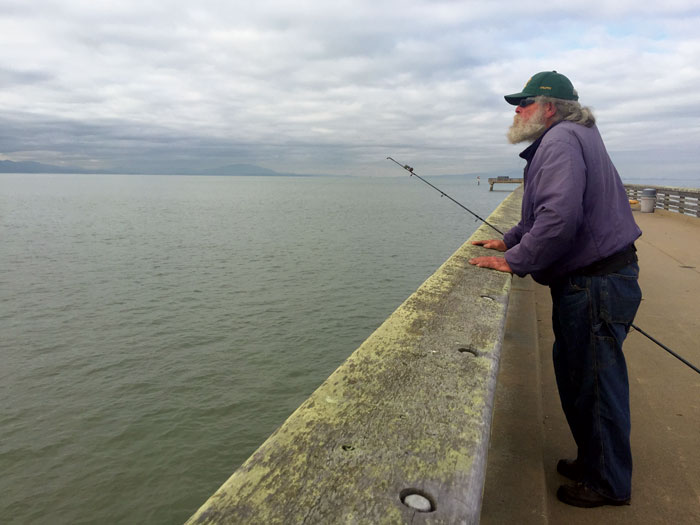
I started fishing when I was a boy growing up in Vietnam during the height of the war. The adults, for the most part, did their best to shield us kids from it, and fishing became an escape from the strife; being on the water was a refuge from the bullets and bombs. On Sundays, we would head to my grandparents’ farm in the country, where we fished for trout and tilapia in the stream that ran through the orchards of mango, jackfruit, guava, and banana trees. The first fish I ever caught was a tiny tilapia from the stream, not much bigger than a child’s hand, but my mom made an elaborate production out of it. She fried it, prepared a special sauce, and made sure everyone in the family tasted my epic achievement.
I see parents and kids fishing from the Point Pinole pier, as they have for generations. The pier stretches 1,250 feet into the Bay and was built in 1977. Park officials say roughly 30 visitors a day come here to fish. But today none of them seem to hail from my home country, so I head back to shore with plans to visit Lake Del Valle next week.
Del Valle and Point Pinole are among the 11 lakes, two piers, and more than 25 miles of Bay and Delta shoreline designated for fishing in the East Bay Regional Park District, covering Alameda and Contra Costa counties. The fish are a mix of nonnative and native species of California halibut, striped bass, jacksmelt, sharks, and rays along the salty shoreline, to rainbow trout, black bass, and catfish further inland. All but two of the lakes are seasonally stocked with trout and catfish.
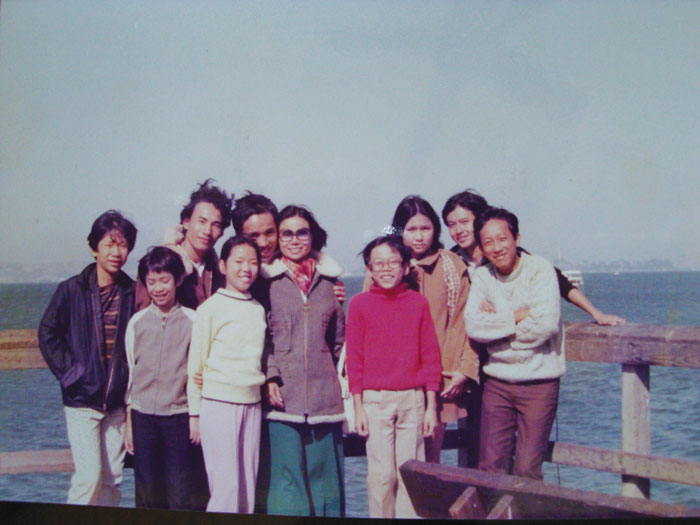
The sun-drenched country road to Lake Del Valle winds through rural Livermore. On its two sides are vineyards and wineries, farmhouses and ranches. Cows, goats, and sheep graze under cottonwood trees and oaks. The road then darts and dips through a series of hills and valleys before ending at Del Valle Regional Park, 4,400 acres of open hills and oak woodlands. Some 15 species of fish reside in the five-mile-long narrow reservoir; most came in from the Delta when water pipes were installed as part of the California State Water Project system.
Lakeside among the anglers, I come upon Rene Plata, who is fishing with his 12-year-old son Alex and 9-year-old daughter Madison. The fish haven’t been biting, but that is beside the point.
“They like getting out here and being involved with Mother Nature,” the 40-year-old Modesto resident says. “It’s a different pace out here. When we’re out here, we talk about life, about events that happen in life, that their life is not just about computer gaming, it’s not about materialistic things. There’s more to life. There’s Mother Nature, there’s the wilderness, not just the techy stuff.”
Plata works inventory control for a food-processing factory in the Central Valley. His grandparents came to Texas from Mexico, but he was born and raised in San Jose. Fishing was part of his growing up.
When my family immigrated as refugees from Vietnam to San Francisco in the summer of 1975, a dozen of us lived crammed in a studio apartment overlooking Dolores Park. At night we slept side by side next to each other on the floor like canned sardines. We didn’t have much, but our family was extremely close—a closeness that strained as we bent to the pressures of school and career and the pursuit of the American dream.
I learned English in public schools, worked as a newspaper boy in the Mission to help out the family. To escape the cramped apartment, my siblings and I would lug our crab nets onto the J Church trolley, transfer to the 47 line, and go hunting for Dungeness crab off the pier at the end of Van Ness Avenue. It was cold and joyous and unforgettable. America was gleaming new to me then, every little thing a wondrous discovery, even the fishing equipment. The poles here were crafted from graphite, carbon, and fiberglass with fancy spinning reels. In Vietnam, a fishing pole was a bamboo stick with a line attached to a hook and sinker.
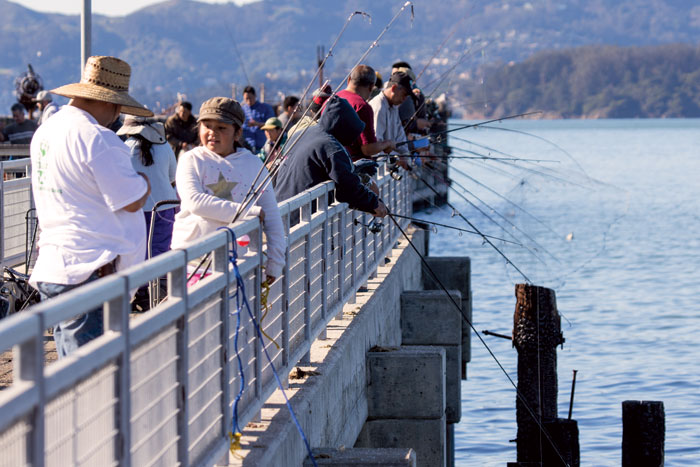
Chatting with Plata and his kids does little to allay my worries about finding a Vietnamese angler. When I get home I call a Vietnamese neighbor with a fishing boat, asking for help locating this elusive fishing community. He has little advice to offer, so I plan to try my luck again at Point Pinole. When I ride the park’s shuttle from the parking lot to the pier—given that it’s a 1.5-mile walk to the pier, it’s a nice service for people with fishing gear—I query Ranger Robb who is driving the shuttle.
“The Vietnamese fishermen tend to fish off the shore because they catch more fish there,” says Robb, who has been a ranger for 17 years. “They’re the only fishermen I see who put on waders.”
On this particular day, however, the shore was almost devoid of people. Out on the pier, I encounter three fishing buddies hanging out together, bantering like teenagers as they cast their lines. Ben Feldman is giving Derek Gust a hard time about his fondness for shrimp chips, a popular Asian snack that can be an acquired taste for Westerners. “I don’t know how you can eat that stuff,” Feldman says, while Kevin Austin nods in agreement. “It’s bait.” The conversation then turns to their shared love of bánh mì, the Vietnamese sandwich.
The three friends—Feldman is a high-tech marketer, Gust is a building contractor, and Austin is a big-rig driver—share a love of fishing. Feldman got to know Gust when Gust did some construction work for him. Austin lives next door to Feldman, and he and Gust have known each other for years.
“We all love San Francisco,” says Feldman, who grew up in Virginia. “I learn from them all the time, as they both grew up here—stuff about the city, stuff about California; more generally, where to fish, how things change season to season and year to year.” He goes on to say that he and Gust share an appreciation for hard cider too. “Kevin is older and has a lot to share about life… It’s good to connect with people who are a little farther down the path, you know. Helps me understand what’s coming my way.”
Fishing, Feldman says, is a pastime that parents can share with their children, a way to be in the outdoors and forge connection with each other. “It’s kind of disappointing,” Feldman says, that “it’s not something that fathers do with their sons anymore…”
Unfortunately, life’s daily demands don’t leave me much time for fishing anymore. Working now as a chef, I am more intimate with preparing seafood than with catching it. My cooking fuses my two cultures, East and West. I’ve discovered that adding a few dashes of fish sauce to garlic, white wine, and butter brings more depth to the traditional shrimp scampi dish. And I’ve found that a sprinkle of chopped kaffir lime leaves on a piece of pan-seared salmon imparts a wonderful citrus fragrance to the fish.
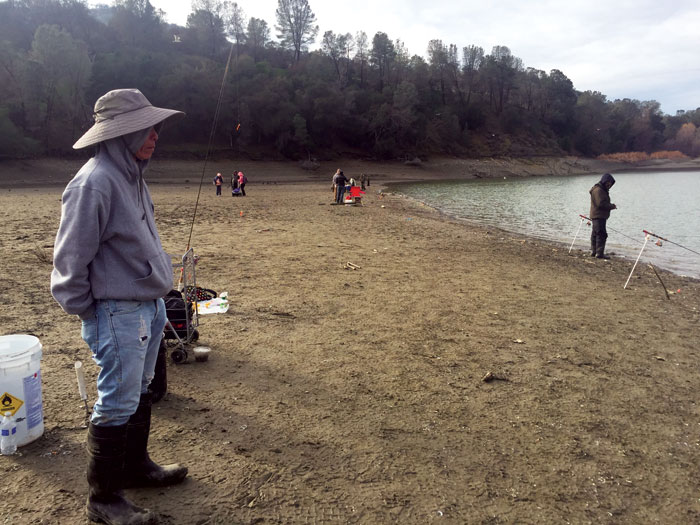
After coming up empty three times, I decide to make one last trip to Del Valle in Livermore. But I’m losing hope. When I arrive at the reservoir, I seek out an expert for help. I’ve heard about Dan “The Captain” Hollis, who works at the Lake Del Valle Marina, a small bait and tackle shop, a place to ease your boat into the water and dock it.
“You get all sorts of people here,” says Hollis. The fishing enthusiasts who have come through the marina resemble members of the cast of Gilligan’s Island: scientists from the nearby Lawrence Livermore National Laboratory, millionaire oil executives, even an occasional Hollywood movie star.
“We’re the last lake before you get out of the Bay Area,” Hollis says. “People come here to get away from the big cities.”
Hollis is part fishing guide, part docent. He says the presence of flocks of birds can tell you where the fish are. He points to where a couple of bald eagles have nested. He loves it most of all when the anglers get the fish to bite. “I want to hear them hooting and hollering when they see their lines jumping,” he says.
There are two things, Hollis says, that anglers hold close to their vests: the baits they use and the locations of their fishing spots. Fishers don’t like to discuss their favorite baits for catching particular fish, be it worms, anchovies, squids, sardines, or PowerBait (used for trout fishing). And all seem to have a favorite fishing spot, Hollis says. “Everyone is super secretive.”
I leave Hollis and look out at Del Valle’s blue expanse. This assignment has become my damned white whale. The closest I’ve come to finding a “thriving” Vietnamese fishing community was a bored Cambodian man skipping rocks at Point Pinole waiting for the fish to bite. But I’ve also found some memories. Looking back at my childhood in Vietnam, I can see that those days fishing on the water gave me a modicum of peace during the war. And in those early days in America, fishing gave me a chance to adapt to the new land by doing something familiar, something connected to my previous life. Fishing is like that. It links the past and present, the old country and New World, the eagerness to catch the fish and the peace that comes while waiting.
And then, just like that, I hooked one. I meet Hao Nguyen. Covered in a hooded jacket, he is casting for rainbow trout at Del Valle with a friend. He has taken in a half dozen trout since the morning. He fishes every chance he gets, sometimes just by himself. His wife often complains, he says. But she fails to understand his obsession. Fishing takes him back to the Mekong Delta of Vietnam where he grew up and used to fish in the streams amid the verdant rice fields. He would use a homemade fishing pole fashioned out of bamboo to troll for catfish and tilapia. The Mekong Delta was the food basket of Vietnam, and its waterways teemed with fish and blue crabs and shrimp. In America, he still cooks the simple country meals of his rural homeland. A striped bass caught from Del Valle, for example, would be turned into a soup with rau ngót, a sweet leaf vegetable from the tropics. Other fish would be fried with lemon grass, with garlic fish sauce for dipping.
“Sometimes I can’t sleep, thinking about it. Everyone has a passion. This is mine,” says the San Jose resident, who works in the computer industry. “Waiting for the fish to bite is one of the great joys in life.”
And it gets me thinking: Maybe I should get back in the game, not so much to catch the fish, but those memories of my youth.
De Tran, a former staff writer at the San Jose Mercury News and the Los Angeles Times, is now a Bay Area executive chef.

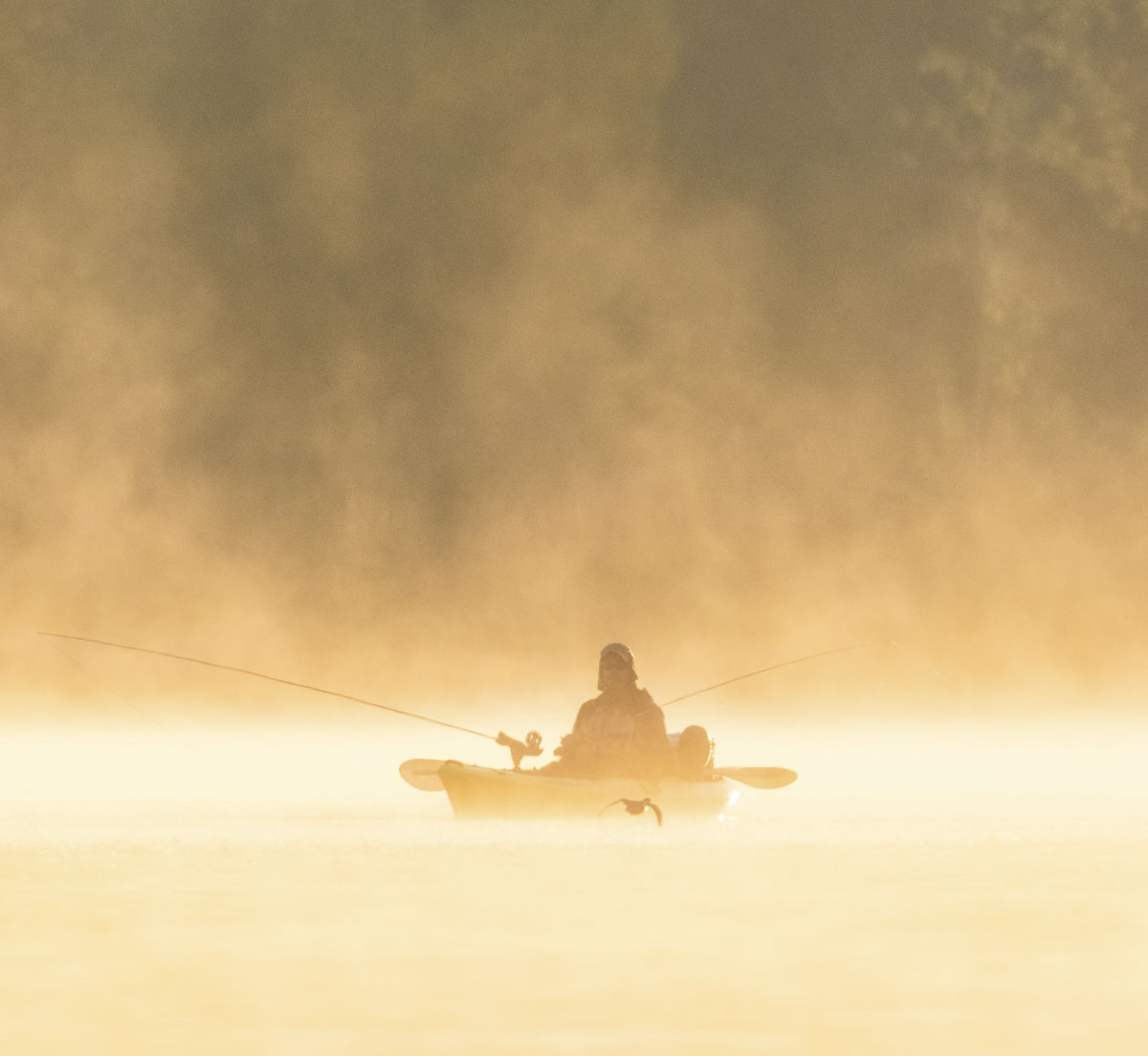
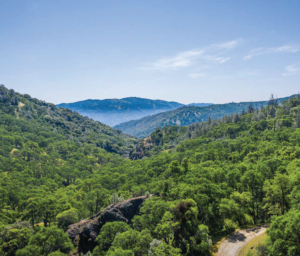
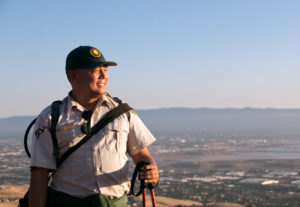

-300x198.jpg)